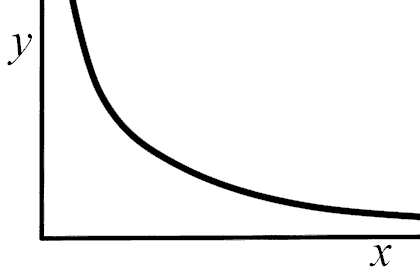Exponential or Inversely Proportional?
Quick question, how would you distinguish between these 2 types of graphs? Haven't got any examples; sorry for being so vague 

Inversely proportional is a straight line with negative gradient. (See my correction edit below)
Exponential is curved either upwards or downwards depending on whether it's a positive or negative exponential.
The one below is a negative exponential for the temperature of an object that is cooling down.

Edit.
My apologies rushing the answers tonight. Inversely prop (eg y=1/x) is not a straight line. It looks very similar to the negative exponential.
Exponential is curved either upwards or downwards depending on whether it's a positive or negative exponential.
The one below is a negative exponential for the temperature of an object that is cooling down.

Edit.
My apologies rushing the answers tonight. Inversely prop (eg y=1/x) is not a straight line. It looks very similar to the negative exponential.
(edited 11 years ago)
Original post by Stonebridge
Inversely proportional is a straight line with negative gradient.
Exponential is curved either upwards or downwards depending on whether it's a positive or negative exponential.
The one below is a negative exponential for the temperature of an object that is cooling down.

Exponential is curved either upwards or downwards depending on whether it's a positive or negative exponential.
The one below is a negative exponential for the temperature of an object that is cooling down.

Doesn't inversely proportional imply y=1/x, so x can never be zero and vice versa? So we have a curve that looks like a negative exponential curve except it's not? Unless I am plotting y against 1/x maybe
Original post by bmqib
Doesn't inversely proportional imply y=1/x, so x can never be zero and vice versa? So we have a curve that looks like a negative exponential curve except it's not? Unless I am plotting y against 1/x maybe
Oops sorry. My mistake rushing the answers tonight.

Yes, inversely proportional is prop to 1/x and is not a straight line.
I was thinking for some reason of negative gradients.
And yes, the curve looks like a negative exponential like the one I posted.
With the difference being posted by the poster below.
(edited 11 years ago)
Erm... an exponential will go through (0,[1 or whatever e is multiplied by]), while 1/x is not defined at x = 0.
Original post by + polarity -
Erm... an exponential will go through (0,[1 or whatever e is multiplied by]), while 1/x is not defined at x = 0.
Yes.
Like this

Wow. This thread was started 7 years ago and I have just returned to TSR after 5 years away. 
If you are asking about the difference between an inverse square and an exponential decay, the simplest visual test, is to look at the value at x=0.
Normally an exponential delay curve starts at some definite point on the y axis and then falls gradually to zero along the x or (very often) the time axis.
An inverse square curve is undefined at x=0 because 1 divided zero is 'infinity'. So it would not have that defined starting point on that vertical y axis as the exponential decay curve would. In fact, it would not touch the y axis at all.
Let me know if this is helpful.

If you are asking about the difference between an inverse square and an exponential decay, the simplest visual test, is to look at the value at x=0.
Normally an exponential delay curve starts at some definite point on the y axis and then falls gradually to zero along the x or (very often) the time axis.
An inverse square curve is undefined at x=0 because 1 divided zero is 'infinity'. So it would not have that defined starting point on that vertical y axis as the exponential decay curve would. In fact, it would not touch the y axis at all.
Let me know if this is helpful.
Quick Reply
Related discussions
- AS logs help
- Alevel maths q help needed
- Econ help - Finding the market Equilibrium
- ac theory question
- Lse Economics and Economic history…help please
- gcse MCQ physics
- Edexcel igcse maths topics
- chemistry help Rates aqa a level
- a level math logs question
- Differential equations
- gimme tips for physics
- A level Physics AQA - Electricity question - not sure how to do
- Edexcel GCSE Mathematics Paper 3 (1MA1 3) - 13th November 2023 [Exam Chat]
- Question
- Physics help
- what particular solution do i use
- Chemistry question Orbitals
- A level physics waves question
- A level physics question
- A level physics electricity question(1)
Latest
Posted 1 minute ago
HMRC reviewing the outcome of pre employment checksLast reply 4 minutes ago
Civil Service Fast Stream 2024 - Applicants threadLast reply 8 minutes ago
Official Cambridge Postgraduate Applicants 2024 ThreadLast reply 9 minutes ago
Inlaks, Commonwealth, and Other Scholarships for Indian Students 2024: ThreadLast reply 10 minutes ago
Official UCL Offer Holders Thread for 2024 entryLast reply 11 minutes ago
Best university for (mechanical) engineering?Last reply 16 minutes ago
2023 ** Borders and Enforcement, Crime & Compliance - ICE - Immigration OfficersLast reply 21 minutes ago
Line breaks are not respected when quoting on React unlike ST2Last reply 22 minutes ago
UOB or BCU for Computer Science conversion degree?Last reply 24 minutes ago
Official MPhil Economics/Economic Research etc Cambridge 2024 ThreadLast reply 26 minutes ago
Bellway Degree Apprenticeship 2024Last reply 26 minutes ago
yet to receive a woodhouse interview


